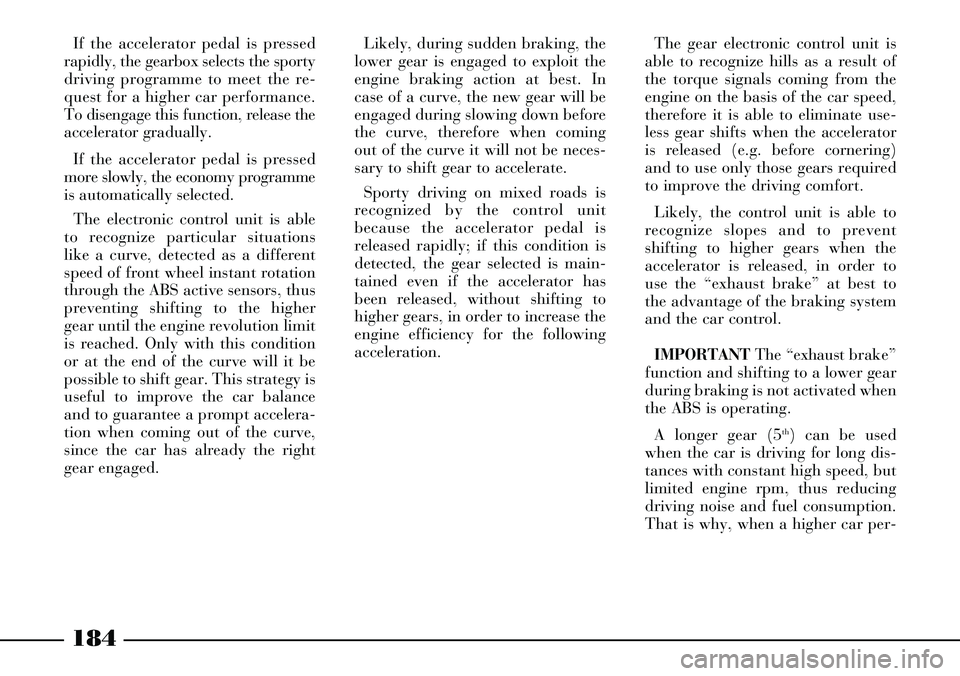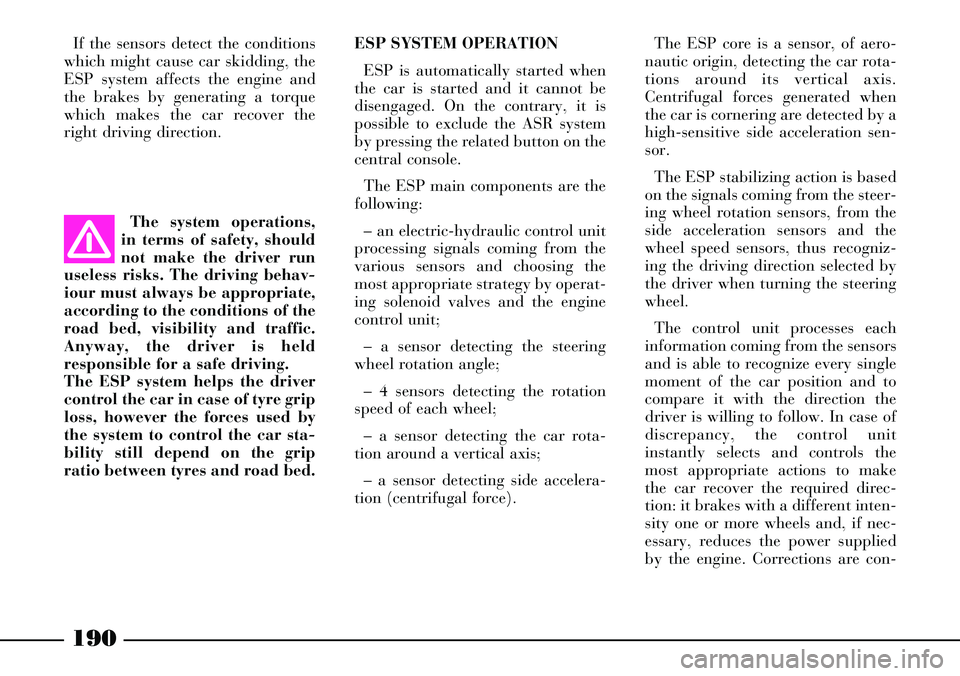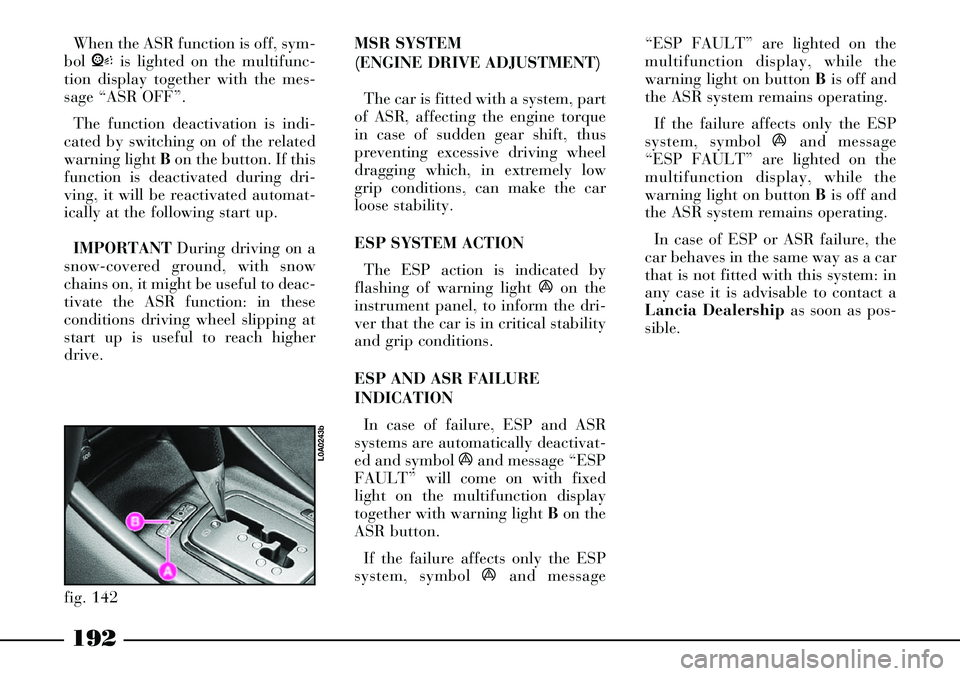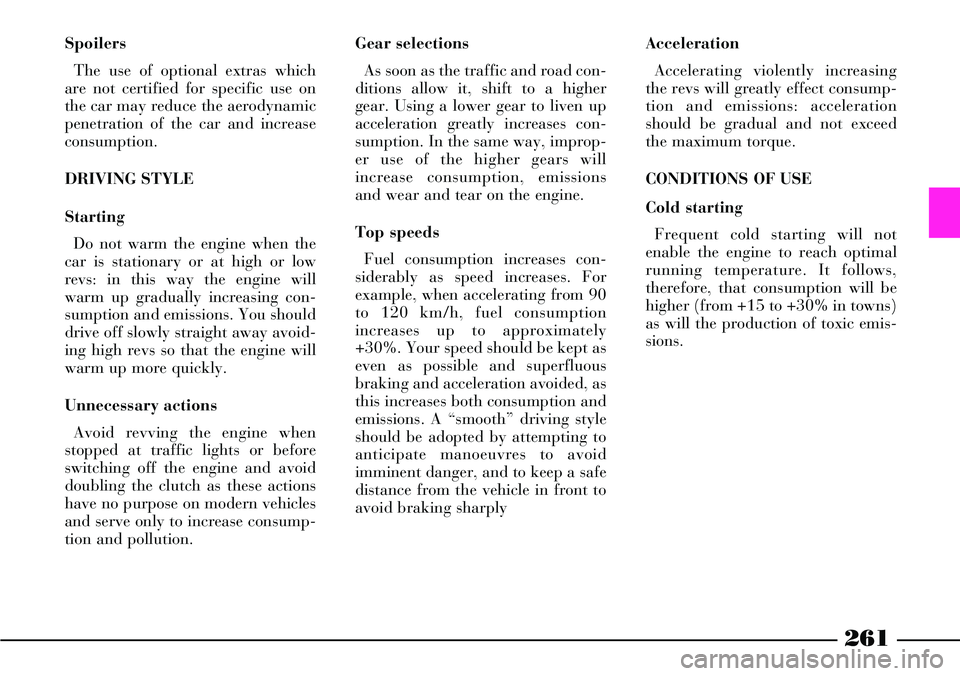torque Lancia Thesis 2007 Owner handbook (in English)
[x] Cancel search | Manufacturer: LANCIA, Model Year: 2007, Model line: Thesis, Model: Lancia Thesis 2007Pages: 386, PDF Size: 8.69 MB
Page 185 of 386

184
If the accelerator pedal is pressed
rapidly, the gearbox selects the sporty
driving programme to meet the re-
quest for a higher car performance.
To disengage this function, release the
accelerator gradually.
If the accelerator pedal is pressed
more slowly, the economy programme
is automatically selected.
The electronic control unit is able
to recognize particular situations
like a curve, detected as a different
speed of front wheel instant rotation
through the ABS active sensors, thus
preventing shifting to the higher
gear until the engine revolution limit
is reached. Only with this condition
or at the end of the curve will it be
possible to shift gear. This strategy is
useful to improve the car balance
and to guarantee a prompt accelera-
tion when coming out of the curve,
since the car has already the right
gear engaged.Likely, during sudden braking, the
lower gear is engaged to exploit the
engine braking action at best. In
case of a curve, the new gear will be
engaged during slowing down before
the curve, therefore when coming
out of the curve it will not be neces-
sary to shift gear to accelerate.
Sporty driving on mixed roads is
recognized by the control unit
because the accelerator pedal is
released rapidly; if this condition is
detected, the gear selected is main-
tained even if the accelerator has
been released, without shifting to
higher gears, in order to increase the
engine efficiency for the following
acceleration. The gear electronic control unit is
able to recognize hills as a result of
the torque signals coming from the
engine on the basis of the car speed,
therefore it is able to eliminate use-
less gear shifts when the accelerator
is released (e.g. before cornering)
and to use only those gears required
to improve the driving comfort.
Likely, the control unit is able to
recognize slopes and to prevent
shifting to higher gears when the
accelerator is released, in order to
use the “exhaust brake” at best to
the advantage of the braking system
and the car control.
IMPORTANTThe “exhaust brake”
function and shifting to a lower gear
during braking is not activated when
the ABS is operating.
A longer gear (5
th) can be used
when the car is driving for long dis-
tances with constant high speed, but
limited engine rpm, thus reducing
driving noise and fuel consumption.
That is why, when a higher car per-
Page 190 of 386

189
If these rules are not
respected, the automatic
gearbox might be severely
damaged.
The car can be towed only for
short distances and at a low
speed: if it is necessary to tow it
for a longer distance, raise the
driving wheels so that the gear-
box is not dragged during towing. TOWING THE CAR
IMPORTANTTo tow the car
observe local current laws and fol-
low the instructions contained in
chapter “In an emergency”.
If the car must be towed, observe
the following precautions:
– if possible, transfer the car on a
towtruck
– otherwise, tow the car by raising
the front driving wheels
– even if the latter solution is not
possible, the car can be towed for
less than 50 Km at a speed of 50
km/h.
Towing shall be performed with
gear lever to N.Before starting towing,
disengage the parking
brake as described in the
relevant paragraph and leave the
Keyless System CID (if any) in the
passenger’s compartment to pre-
vent automatic steering lock. Do
not tow the car with the engine
running.
ESP AND ASR
SYSTEMS
ESP SYSTEM (ELECTRONIC
STABILITY PROGRAM):
GENERAL
ESP is an electronic system con-
trolling the car stability which
affects the driving torque and brakes
the wheels in a different way in case
of grip loss, thus making the car
recover the right driving direction.
During driving the car is subject to
side and longitudinal forces which
can be controlled by the driver until
tire grip is acceptable. When the lat-
ter is lower than the minimum level,
the car starts skidding.
If the road bed is uneven (bumpy
road, presence of ice, mould, etc.)
tyre grip is considerably reduced. In
these conditions, when extreme
manoeuvres are made, the car might
start skidding.
Page 191 of 386

190
If the sensors detect the conditions
which might cause car skidding, the
ESP system affects the engine and
the brakes by generating a torque
which makes the car recover the
right driving direction.
The system operations,
in terms of safety, should
not make the driver run
useless risks. The driving behav-
iour must always be appropriate,
according to the conditions of the
road bed, visibility and traffic.
Anyway, the driver is held
responsible for a safe driving.
The ESP system helps the driver
control the car in case of tyre grip
loss, however the forces used by
the system to control the car sta-
bility still depend on the grip
ratio between tyres and road bed.ESP SYSTEM OPERATION
ESP is automatically started when
the car is started and it cannot be
disengaged. On the contrary, it is
possible to exclude the ASR system
by pressing the related button on the
central console.
The ESP main components are the
following:
– an electric-hydraulic control unit
processing signals coming from the
various sensors and choosing the
most appropriate strategy by operat-
ing solenoid valves and the engine
control unit;
– a sensor detecting the steering
wheel rotation angle;
– 4 sensors detecting the rotation
speed of each wheel;
– a sensor detecting the car rota-
tion around a vertical axis;
– a sensor detecting side accelera-
tion (centrifugal force).The ESP core is a sensor, of aero-
nautic origin, detecting the car rota-
tions around its vertical axis.
Centrifugal forces generated when
the car is cornering are detected by a
high-sensitive side acceleration sen-
sor.
The ESP stabilizing action is based
on the signals coming from the steer-
ing wheel rotation sensors, from the
side acceleration sensors and the
wheel speed sensors, thus recogniz-
ing the driving direction selected by
the driver when turning the steering
wheel.
The control unit processes each
information coming from the sensors
and is able to recognize every single
moment of the car position and to
compare it with the direction the
driver is willing to follow. In case of
discrepancy, the control unit
instantly selects and controls the
most appropriate actions to make
the car recover the required direc-
tion: it brakes with a different inten-
sity one or more wheels and, if nec-
essary, reduces the power supplied
by the engine. Corrections are con-
Page 193 of 386

192
When the ASR function is off, sym-
bol Vis lighted on the multifunc-
tion display together with the mes-
sage “ASR OFF”.
The function deactivation is indi-
cated by switching on of the related
warning light Bon the button. If this
function is deactivated during dri-
ving, it will be reactivated automat-
ically at the following start up.
IMPORTANTDuring driving on a
snow-covered ground, with snow
chains on, it might be useful to deac-
tivate the ASR function: in these
conditions driving wheel slipping at
start up is useful to reach higher
drive.MSR SYSTEM
(ENGINE DRIVE ADJUSTMENT)
The car is fitted with a system, part
of ASR, affecting the engine torque
in case of sudden gear shift, thus
preventing excessive driving wheel
dragging which, in extremely low
grip conditions, can make the car
loose stability.
ESP SYSTEM ACTION
The ESP action is indicated by
flashing of warning light áon the
instrument panel, to inform the dri-
ver that the car is in critical stability
and grip conditions.
ESP AND ASR FAILURE
INDICATION
In case of failure, ESP and ASR
systems are automatically deactivat-
ed and symbol áand message “ESP
FAULT” will come on with fixed
light on the multifunction display
together with warning light Bon the
ASR button.
If the failure affects only the ESP
system, symbol áand message“ESP FAULT” are lighted on the
multifunction display, while the
warning light on button Bis off and
the ASR system remains operating.
If the failure affects only the ESP
system, symbol áand message
“ESP FAULT” are lighted on the
multifunction display, while the
warning light on button Bis off and
the ASR system remains operating.
In case of ESP or ASR failure, the
car behaves in the same way as a car
that is not fitted with this system: in
any case it is advisable to contact a
Lancia Dealershipas soon as pos-
sible.
fig. 142
L0A0243b
Page 262 of 386

261
Gear selections
As soon as the traffic and road con-
ditions allow it, shift to a higher
gear. Using a lower gear to liven up
acceleration greatly increases con-
sumption. In the same way, improp-
er use of the higher gears will
increase consumption, emissions
and wear and tear on the engine.
Top speeds
Fuel consumption increases con-
siderably as speed increases. For
example, when accelerating from 90
to 120 km/h, fuel consumption
increases up to approximately
+30%. Your speed should be kept as
even as possible and superfluous
braking and acceleration avoided, as
this increases both consumption and
emissions. A “smooth” driving style
should be adopted by attempting to
anticipate manoeuvres to avoid
imminent danger, and to keep a safe
distance from the vehicle in front to
avoid braking sharplyAcceleration
Accelerating violently increasing
the revs will greatly effect consump-
tion and emissions: acceleration
should be gradual and not exceed
the maximum torque.
CONDITIONS OF USE
Cold starting
Frequent cold starting will not
enable the engine to reach optimal
running temperature. It follows,
therefore, that consumption will be
higher (from +15 to +30% in towns)
as will the production of toxic emis-
sions. Spoilers
The use of optional extras which
are not certified for specific use on
the car may reduce the aerodynamic
penetration of the car and increase
consumption.
DRIVING STYLE
Starting
Do not warm the engine when the
car is stationary or at high or low
revs: in this way the engine will
warm up gradually increasing con-
sumption and emissions. You should
drive off slowly straight away avoid-
ing high revs so that the engine will
warm up more quickly.
Unnecessary actions
Avoid revving the engine when
stopped at traffic lights or before
switching off the engine and avoid
doubling the clutch as these actions
have no purpose on modern vehicles
and serve only to increase consump-
tion and pollution.
Page 281 of 386

280
Bolt tightening torque
must be 98 Nm (10 kgm).
After replacing the
wheel, you are advised to have
the wheel bolt tightening checked
at a Lancia Dealership as soon as
possible.
Insufficient tightening could
actually make the wheel bolts
loosen too much, with clearly
dangerous consequences. If the
bolts are tightened too much, they
could be damaged and their
resistance might be compro-
mised.23) Place the removed wheel, the
jack and the tools in the boot and
fasten appropriately.
IMPORTANTPut the jack back
into B(fig. 8) and clamp it by
screwing handle A(fig. 8) manually
in order to prevent vibrations during
travelling.
fig. 19
L0A0045b
fig. 20
L0A0365b
fig. 21
L0A0368b
21) Tighten up the wheel bolts in a
criss-cross fashion, following the
sequence shown:
- fig. 19= versions with alloy rims
- fig. 20= versions with steel rims.
22) On versions with alloy rims,
refit the wheel hub cap pressing it
slightly. On versions with steel rims,
approach the wheel cap making the
inflating valve A(fig. 21) coincide
with flaring B. Press the cap circum-
ference starting near the inflating
valve and proceeding until fitting
the cap completely.
IMPORTANTThe wheel hub cap
(alloy rims) or the wheel cap (steel
rims) may fly off when the car is
moving if it is not fastened correctly.
Page 345 of 386

344
2.0 TB
841E000
Front,
transversally-mounted
Otto
5 in line
4 - Hydraulic
tappets
82 x 75.65
1,998
8.5 : 1
136
185
5,500
308
31.4
2,200
Unleaded
petrol 95 R.O.N. 2.4
841D000
Front,
transversally-mounted
Otto
5 in line
4 - Hydraulic
tappets
83 x 90.4
2,446
10.3 : 1
125
170
6,000
226
23.0
3,500
Unleaded
petrol 95 R.O.N. 2.4 CAE
841D000
Front,
transversally-mounted
Otto
5 in line
4 - Hydraulic
tappets
83 x 90.4
2,446
10.3 : 1
125
170
6,000
226
23.0
3,500
Unleaded
petrol 95 R.O.N.
ENGINE
GENERAL FEATURES
Engine code
Location
Cycle
Number and layout of cylinders
Number of valves per
cylinder
Diameter x stroke mm
Total capacity cc
Compression ratio
Maximum power (EEC): kW
HP
corresponding ratio rpm
Maximum torque (EEC): Nm
Kgm
corresponding ratio rpm
Fuel
Page 346 of 386

345
3.2 V6 CAE
841L000
Front,
transversally-mounted
Otto
6 V, 60°
4 - Hydraulic
tappets
93 x 78
3,179
10 : 1
169
230
6,200
289
29
4,800
Unleaded
petrol 95 R.O.N. 2.4 JTD 20V CAE
841H000
Front,
transversally-mounted
Diesel
5 in line
4 - Hydraulic
tappets
82 x 90.4
2,387
17 : 1
136
185
4,000
330
34
1,750
Diesel fuel for
motor vehicles
GENERAL FEATURES
Engine code
Location
Cycle
Number and layout of cylinders
Number of valves per
cylinder
Diameter x stroke mm
Total capacity cc
Compression ratio
Maximum power (EEC): kW
HP
corresponding ratio rpm
Maximum torque (EEC): Nm
Kgm
corresponding ratio rpm
Fuel
Page 366 of 386

365
Use
(*) IMPORTANT Do not top up or mix with fluids having characteristics different from those specified.Applications
Mechanical gearbox and
differential petrol version
Mechanical gearbox and
differentials, diesel versions
Power steering
5-speed automatic
transmission
CV joints on wheel side
CV joints on differential side
Brake and clutch hydraulic
control
Cooling circuits
Proportion:
50% water and
50% Paraflu UP
To be used diluted
or undiluted Original fluids
and lubricants
TUTELA CAR
TECHNYX
TUTELA CAR
MATRYX
TUTELA GI/E
TUTELA GI/V
TUTELA STAR 500
TUTELA
MRM ZERO
TUTELA TOP 4
PARAFLU UP (*)
TUTELA
PROFESSIONAL
SC 35 Fluid and lubricant specifications
for correct car operation
Synthetic-based oil, grade SAE 75W-85 that passes
API GL 4 specifications Plus, Fiat 9.55550.
Synthetic-based oil, grade SAE 75W-85, that pass
API GL4 specifications.
"ATF DEXRON III" oil..
Special lubricant for 5-speed transmissions with
controlled slip torque converters
Lithium-soap-based grease with molybdenum
bisulphate. Consistency NLGI 2
Lithium soap based grease. NLGI 0 consistency
Synthetic fluid FMVSS no. 116, DOT 4, ISO 4925,
SAE J-1704 CUNA NC 956-01
Protective with antifreeze action, red colour based on
inhibited monoethylen glycol and organic formula, that
passes CUNA NC 956-16, ASTM D 3306 specifications
Mixture of alcohol, water and surfactants
CUNA NC 956-11 Brake fluid Transmission
and hydraulic
power steering
lubricants and
greases
Protective agent
for radiators
Windscreen/
headlight washer
fluid